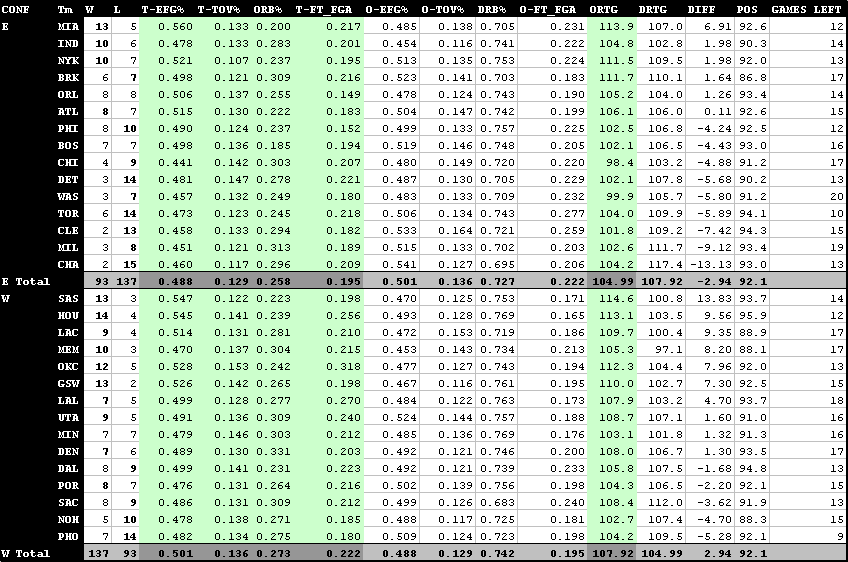All's Quiet on the Eastern Front
Posted on Tue 15 January 2013 in The Stats They Carried by Aaron McGuire

Hey, all. For today's post, I'd like to present some cross-conference matchup data. A lot of people discuss cross conference games from a perspective of raw wins and losses. I'm amenable to that, in the aggregate -- there are usually enough games that looking at raw intraconference wins/losses can give valuable results. Still, there's generally more insight to be gained by looking a tad bit behind the numbers -- not simply the raw number of wins, but how they came about, what sort of statistical quirks underlie them, and what teams are best against the opposing conference. You know, all that jazz. So come with me, friends, and let's get behind a few of the preliminary factors that drive 2013's main inter-conference trends, and note a few interesting quirks
Full-size table after the jump.
• • •

I'm rather busy and crunched for time today, but here are a few observations.
-
First, while this isn't a historically lopsided cross-conference split, these are still some pretty startling numbers. The West has won 137 of 230 cross-conference games -- 59.6% of their cross-conference games, overall. The West has an efficiency differential of 2.94 against the East. In a single team, that differential and that winning percentage would translate to a 4/5 seed. And those numbers were arrived at despite, obviously, having heavy game coverage from the lower-tier western teams. Look at Phoenix, for instance -- they've already played 21 of their 30 cross-conference games, which means they have fewer games to go than several better western teams. A few teams of note:
-
Denver has looked pretty good in recent months, but their poor record against the East is one of the reasons they've yet to crack the West's top 5. It's possible -- even likely -- that they'll regress to their mean and post a better record in the second half of the season. Same is true about the Lakers, Grizzlies, and Clippers (all of whom have a lower-than-expected record against the East.)
-
Sacramento and Dallas -- despite overall records under 0.420 -- are barely below 0.500 against the Eastern conference. In fact, almost nobody in the West is. Only four teams are, actually with just Phoenix and New Orleans below 0.400. The inverse is true in the East, where all but four teams (Miami, Indiana, New York, and Atlanta) are below 0.500 against their Western brethren.
-
The San Antonio Spurs have won their eastern games by an average of 13 points per 100 possessions. This is despite sitting everyone with a pulse against Miami and playing 9 of their 16 Eastern games on the road. Also: despite their 2OT game against the Raptors.
-
How is the West doing it? Offense and defense. Fun fact: the East is marginally better on defense than the West over all games played (the East has posted a defensive rating of 105.9 by my numbers while the West is at 106.2), but in cross-conference matchups, the Western defensive attack tends to shut down the East's weaker teams while the Western offensive attack tends to obliterate the East's defenses. While the West gets about a point-per-100-possessions better defensively when they're facing the East, the Western offensive attack absolutely fillets a weaker-than-it-looks slate of defensive looks, especially for poor defensive teams like the Bobcats, Nets, and Bucks.
-
Going forward, most would intuitively assume there's a good chance this regresses to a less lopsided mean and the East closes the gap a bit. In theory, right? In actuality, I'm not at all sure this is going to happen, and it's more likely to get worse. The thing that one has to understand is that the current distribution of teams played actually tends to favor the East. Washington, Milwaukee, and Cleveland -- all teams that have been dismal against the West -- have a combined 54 cross-conference games left. Conversely, the East's 3 best teams against the West (Miami, New York, Indiana) have just 39 cross-conference games left! Although San Antonio has already played 16 of their 30 Eastern games, the Clippers, Grizzlies, and Nuggets combine for 51 remaining games. If you calculate out a full-season expectation for the final West/East win total, you get a number even worse for the East than the current reality, with the West going 271 to the East's 179 wins -- a final percentage of 60.2% in favor of the West.
- The other issue that could exacerbate matters for the East is that of the playoff picture. If the East featured several teams racing for a playoff spot, you might expect teams to hold off worrying about lottery positioning until they were mathematically eliminated for the playoffs. But as things stand, there are about six Western teams racing for the last 2 playoff spots with legitimate cases that all but about 3 Western teams could make the playoffs -- that stands in stark contrast to the East, where one could make a relatively strong argument that the eight playoff spots are already completely decided. If the pressures of lottery-tanking start to depress the fortunes of the East's worst teams, that's only going to worsen the picture against a Western conference with enough legitimate playoff contenders to fill a league.
• • •